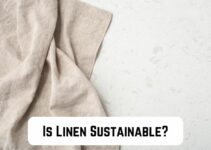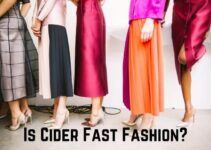The fashion industry is the 3rd biggest polluter in the world. It contributes up to 10% of our entire carbon footprint each year. To put that into perspective, it’s still a bigger polluter than if you combine the carbon footprint of all our cargo ships and international flights all year round.
But did you know that we now have the means to combat this and hopefully slowly restore the overall health of our environment? Let me introduce you to the counterpart of fast fashion: slow fashion. Here’s what you need to know about this movement.
Read: How Does Biodiversity Contribute to the Sustainability of an Ecosystem?
What is Considered Slow Fashion?
Slow fashion is a movement and approach to fashion that emphasizes quality, sustainability, and longevity over the rapid production, consumption, and disposal that characterizes much of the fast fashion industry.
The term “slow fashion” is inspired by the “slow food” movement, which promotes local food and traditional cooking as an alternative to fast food. It emphasizes the importance of quality over quantity and encourages consumers to buy fewer, better-made garments that are designed to last.
Slow Fashion also promotes fair labor practices and supports local artisans and small businesses. Slow fashion aims to reduce the fashion industry’s negative impact on the environment and society by promoting responsible consumption and production.
Any high-quality garment designed to last for years and produced in small batches can be considered slow fashion. It’s an approach to fashion that focuses more on quality than quantity.
But remember that slow fashion isn’t just about using high-quality materials. We can also consider clothes you can wear for any occasion as “slow fashion.” That’s because the concept of “going at a slow pace” also refers to the design, not just the materials.
Here are some key principles and characteristics of slow fashion:
- Sustainability: Slow fashion prioritizes the use of sustainable materials and environmentally friendly production processes to reduce carbon footprints and waste.
- Quality Over Quantity: Instead of producing large quantities of low-quality, disposable clothing, slow fashion focuses on creating fewer, higher-quality items that last longer.
- Ethical Production: This means ensuring fair wages, safe working conditions, and decent treatment of workers throughout the supply chain.
- Transparency: Brands that advocate for slow fashion often provide information about where and how their products are made, so consumers can make informed choices.
- Timelessness: Slow fashion tends to favor classic and versatile designs over trendy, quickly outdated ones. This means that clothing items remain relevant and wearable for many seasons or even years.
- Consumer Awareness: Consumers are encouraged to be more mindful of their purchases, considering the lifespan of an item and its impact on the environment before buying.
- Repair, Redesign, and Upcycle: Instead of discarding damaged or old clothing, the emphasis is on repairing, redesigning, or upcycling them to extend their lifespan.
- Local Production: Slow fashion often promotes local artisans and production to reduce transportation emissions and to support local economies.
- Less is More: The movement encourages consumers to buy fewer items, choosing quality over quantity, and to think of purchases as long-term investments.
- Support for Artisans: Slow fashion values the skills and crafts of artisans, often highlighting handmade, unique, or culturally significant pieces.
The slow fashion movement challenges the norms of the fashion industry by questioning the ethics and sustainability of mass production. By making thoughtful choices about what to buy and wear, supporters of slow fashion aim to reduce waste, decrease the industry’s environmental impact, and promote more ethical labor practices.

What is the Slow Fashion Movement?
The slow fashion movement is all about promoting social and environmental justice in the fashion industry. It aims to spread awareness about the negative impacts of fast fashion’s overproduction and overconsumption.
For this advocacy to be successful, it needs several philosophies or principles to drive it forward. For starters, it encourages fashion brands to reevaluate their production practices to produce minimal waste and maybe even stop the need for harmful chemicals.
Secondly, the slow fashion movement reiterates the need to stop overproduction by asking brands only to make clothes on a pre-order basis. If that’s not possible, then they should at least minimize the size of their batch production.
Aside from making sure these brands don’t have unsold inventory, this practice will also ensure that the fashion industry only has the necessary supply for the current demand (thus reducing waste).
The movement also wants to ensure that employees or garment workers have healthy working conditions and receive livable wages. The last principle concerns transparency. One of the biggest issues the fashion industry faces is unfair labor practices.
By pressuring brands to provide an uncomplicated supply chain, consumers, agencies, and third-party auditors can guarantee that the materials and labor involved in manufacturing these clothes come from safe and fair environments.
How Can You Join the Slow Fashion Movement?
As a manufacturer, you can join the slow fashion movement by limiting the production quantity of your products to only what’s necessary. As a consumer, you must shop mindfully and ensure you only purchase from slow or sustainable fashion brands.
Here are some detailed steps you can take to be part of the fashion statement that saves the world.
As a Manufacturer
If you are a fashion brand, you can employ many methods to support the slow fashion movement. Here are some of them.
- Limit Production
Remember that “slow” is the operative word in “slow fashion.” You want to slow down the production of new products to reduce the waste that goes into landfills. Limiting your production also means there’s less carbon footprint during the transportation of materials and products.
- Focus on Quality
Another way to ensure there’s less textile waste that goes into landfills is to produce clothes that are made to last. Instead of mass-producing fashion pieces that don’t last longer than two years, it’s better to shift your resources to fewer pieces of clothes with longer lifespans.
- Use Eco-Friendly Materials
Wool, linen, and organic cotton have little impact on our environment, which makes them ideal materials for eco-friendly products. These materials do not use harmful chemicals and consume less water during manufacturing.
You can even switch to biodegradable fabrics to further help the environment.
As a Consumer
It’s not just the manufacturers that should carry the responsibility of saving the environment. Consumers must also make conscious choices to ensure they don’t contribute to the overall carbon footprint of the fashion industry.
- Adjust Your Shopping Habits
It’s not unusual for consumers to assume they can’t influence the business decisions of a conglomerate brand. But imagine if all of us collectively decided to prioritize quality over quantity. The low demand for cheap and trendy garments will force every brand to switch to slow fashion.
Ergo, one of the best things you can do to be part of the slow fashion movement is to adjust your shopping habits and purchase high-quality clothes you can use for years.
- Take Care of Your Clothes
The slow fashion movement was established in the first place to reduce the fashion industry’s waste that goes into landfills. If you take care of your clothes and increase their life cycles, you’re already contributing to the advocacy.
- Thrift Stores
If you really need to buy clothes, consider going to a thrift store instead. This keeps the clothes out of landfills and reduces the demand for new, mass-produced fashion pieces. Besides, nothing compares to the joy of treasure hunting in a thrift shop for a good find!
- Look for Certifications
Unsure how to determine whether or not a brand is part of the slow fashion movement? Look for GOTS and Oeko-Tex certifications. GOTS stands for Global Organic Textile Standard. If a brand has this, it means they abide by fair-trade regulations and produce clothes that don’t significantly impact the environment.
On the other hand, Oeko-Tex means a textile is ecological (Öko = eco, tex = textile). In other words, a product with Oeko-Tex certification tested negative for chemicals known to be harmful to humans and the environment.

Why Does Slow Fashion Matter?
Slow fashion is important because it helps slow down the depletion of the earth’s natural resources. It also reduces the waste produced by the fashion industry, thus helping the environment heal.
Think of the earth’s resources as water in a bucket. Now, imagine that our consumer behavior regarding fashionable clothes is a huge hole at the bottom of that bucket. If we continue at the rate by which we demand water out of that bucket, it’s only a matter of time before it drains.
Slow fashion helps shrink that hole by lowering the demand for new clothes. Furthermore, the movement also aims to switch to other sources of material, ultimately avoiding the need to get more water out of our hypothetical bucket.
Is Slow Fashion Sustainable?
Yes, slow fashion is inherently sustainable. The advocacy consists of several principles that align with sustainable fashion practices, but sustainability often encompasses a broader aspect of the fashion industry.
What does that mean? The primary emphasis in slow fashion is a lower rate of production and a more mindful approach to consumer behavior. These principles push the main objective of sustainability, but they don’t cover sustainable fashion as a whole.
Slow Fashion vs Sustainable Fashion
While used interchangeably, slow fashion and sustainable fashion differ in terms of design, source of materials, and their main driving principles.
To better understand that, here are some aspects where you can see the differences between slow and sustainable fashion.
Design
As I’ve mentioned earlier, slow fashion usually consists of timeless designs to ensure you can use them, whatever the current trends are.
While sustainable fashion may include classic pieces, it’s not strictly confined to this aesthetic. Sustainable fashion sometimes incorporates innovative motifs that align them closer to modern trends.
Source of Materials
Slow fashion prefers sourcing materials from local suppliers. The main goal is to reduce the fashion industry’s carbon footprint by shortening the transportation distance.
While this aligns with the principles of sustainable fashion, it’s not entirely restricted to local artisans. Sustainable fashion may embrace global resources as long as the entire process is ethical and responsible.
Read: What Effect Do Keystone Species Have on an Ecosystem?
Main Driving Principles
Slow and sustainable fashion’s driving principles may overlap, but they mainly focus on two different things. Slow fashion emphasizes slowing down the production and consumption of new clothes, hence the term.
This principle helps champion sustainability, but sustainable fashion is an umbrella that covers every aspect of production. This includes the social and environmental impact of the fashion industry as a whole.
The Similarity
Nonetheless, both slow and sustainable fashion aim to safeguard the quality of life and safety of the workers involved in the production process of new clothes. Furthermore, one of their guiding principles is to educate consumers on responsible purchasing, caring for, and disposing of their clothes.
Finally, slow and sustainable fashion are geared toward improving our environment by ensuring we don’t rapidly deplete our earth’s natural resources. This includes switching to renewable energy, reducing wastewater, and properly disposing surplus textiles.
Conclusion
In life, some things are better if we take them slow. One of those is fashion. By switching to slow fashion, we don’t just avoid the extra costs of rapidly changing fashion trends, but we also get to save the environment.
And at a time when environmental responsibility is mostly needed, this approach is the answer to combat the global pollution brought on by the fashion industry. So, the next time you shop for new clothes, consider the brands pushing this advocacy forward.




